Mason bee houses
Mason bee houses are a great addition for any pollinator friendly yard. About a month ago, I celebrated my 26th birthday and wanted to also help make things for a community garden I’m helping plan. My mom had a great idea to make bird houses, butterfly houses and bee mason houses. The catch? Each family had to use scrap they already had laying around.
This post contains affiliate links.
We split up the plans between the families, and each family brought five projects with them. Three were split between the families, then two were donated to the community garden. This post is the first of three posts on the benefits of each pollinator, how to attract and support them in your yard.
What are mason bees?
Mason bee houses are a great way to encourage mason bees to inhabit your garden. We’ll get the importance of garden pollinators soon, but first, what are mason bees?
Mason bees are a little smaller than a honeybee, and metallic blue or blue-black in color. They get their name from their habit of nest-building, which is to seal off the cells where they lay their eggs, with a mortar-like application of mud.
Unlike honey bees, mason bees are native to North America. This alone makes them more stable and more capable of handling North American conditions. There is more than 140 species of mason bees in North America.
The Importance of Garden Pollinators
Mason bees, along with other garden pollinators, are responsible for one of the most critical roles in our ecosystem. Pollinators are essential for flowering plant reproduction and in the production of most fruits and vegetables. Without the assistance of pollinators, most plants can’t produce fruits and seeds.
Benefits of Solitary Bees
By now, most of us are aware of the extreme stress honeybee populations are under. Here solitary bees, such as mason bees, have the advantage because they are solitary insects. They are less susceptible to disease and stress. They also can’t be used in the high-stress farming methods in industrial agriculture.
Another benefit is the males do not have a stinger, and the females will only sting if trapped or squeezed. This makes them an ideal neighbor for the home garden.
How to attract mason bees
There are quite a bit of things we can do to attract bees to our yard.
Plant a bee-friendly garden
Intensive monoculture-based farming practices, pristine green (but flower-barren) sprawling suburban lawns and from the destruction of native landscapes are responsible for garden pollinator habitat loss.
Flowers provide bees with forage. Since bees like volume of forage (a sq. yard is a good estimate), so plant plenty of the same type of bloom together. For a great list of plants honeybees love click here. Also, five or six large trees can provide as much forage for bees as an acre of wild flower meadow. They also provide a single source of nectar that bees find easy to harvest.
Additionally, bees need water. If you have a lot of bees starting to come to your new garden of native plants, wildflowers and flowering herbs, put a little water basin out (a bird bath with some stones in it for them to crawl on does a nice trick).
Avoid chemically treated flowers
Chemicals on treated flowers or plants leach into pollen. This includes spraying in your yard and when purchasing plants with your garden. Although, Lowe’s announced it was phasing out neonicotinoid pesticides, but it’s a lesson learned. Research the nurseries in your area and make sure you’re supporting reputable, organic growers.
If you do use pesticides, avoid using them when the flowers are in bloom. The pesticides are less likely to reach the pollen.
Plant native plant species
Native plants also oftentimes require less water and fertilizer than non-native plants. This will vary from place to place, but as a general rule bees don’t like red or pink nor do they like double topped flowers such as double impatiens because they produce little nectar and it’s hard to get to.
Plan for blooms year-round.
Plant at least three different types of flowers to ensure blooms through as many seasons as possible, thus providing bees with a constant source of food.
How to help bees
Start a honeybee hive
You can directly impact the health of your local ecosystem by starting a honeybee hive. Plus, you get the added benefits of bee products such as honey, beeswax, as well as the satisfaction and joy derived from working with a hive. Contact your local beekeeping club for more information.
Sponsor a Hive
If you can’t start your own hive or would like to help increase the number of hives, why not help fund new hive installations? The Honeybee Conservancy is working with Bee Native to install stocked honeybee hives and provide beekeeping training to American Indian communities across the U.S.
Support your local beekeeper
Support local beekeepers who nurture their bees while providing local communities with healthy bee products including honey.
If you’re not able to buy directly from a local beekeeper, here are a few guidelines to think about in the store: Here’s a few guidelines:
First, don’t buy honey that says anything about being from China. In that case, it’s more likely to be corn syrup than real honey.
If it’s coming from the grocery store, but it doesn’t say the words “pure” or “raw” and you can’t read in the description that it’s untreated by chemicals, don’t buy it. If it’s untreated, the label will say, as this is an important selling point. We recommend a simple solution for most people. Go to your farmer’s market and shake hands with the beekeepers you meet. There are beekeepers at nearly every farmer’s market selling their honey and other products. Have a conversation with them, find out what they are doing to their hives, and how they are keeping their bees. If they are thoughtful, respectful beekeepers who keep their bees in a sustainable, natural way, then make a new friend and support them!
Protect bee habitat
One of the largest threats to bees is the lack of habitat due to urban sprawl. You can volunteer to plant native vegetation such as wildflowers along roadways and other common areas, and advocate sensible limits to development where you live. Build homes for native bees. Since many native species of bees build their nests in undisturbed land, why not keep an undisturbed plot of land for them in your garden?
Purchase organic foods
Whenever possible purchase from organic farmers or ask your local farmers to stop using pesticides. If possible, don’t support farms or food companies that use pesticides.
How to build mason bee houses with scrap wood
My aunt and her husband have started a homestead. They started with bees and recently added some little piglets. Naturally, I wanted them to bring the mason bee houses. They used 4 x 4 cedar posts leftover from their porch project.
Mason Bee House Materials Needed:
- 4 x 4 untreated scrap wood (we used cedar)
- Drill and 5/16 Bit
- Scrap Fence panel
- Staples or finishing nails
Step One. Cut Posts.
First, cut the 4 x 4 posts to size. Ours were about 12 x 4 x 4.
Step Two. Drill Holes.
Drill 5/16” holes throughout the post. They don’t need to be perfectly symmetrical or perfectly straight lines.
Step Three. Finishing Touches.
Next add a roof, that’s just slightly longer the wooden post. Then add a rope trim around the sides. Make a loop with rope and attach on the back as a hanger.
Step Four. Decorate!
You don’t need to decorate, but it sure is fun and will add color to your yard.
We hope you enjoyed our mason bee houses. Stay tuned for upcoming bird houses and butterfly houses!
Don’t forget to pin this post for later.
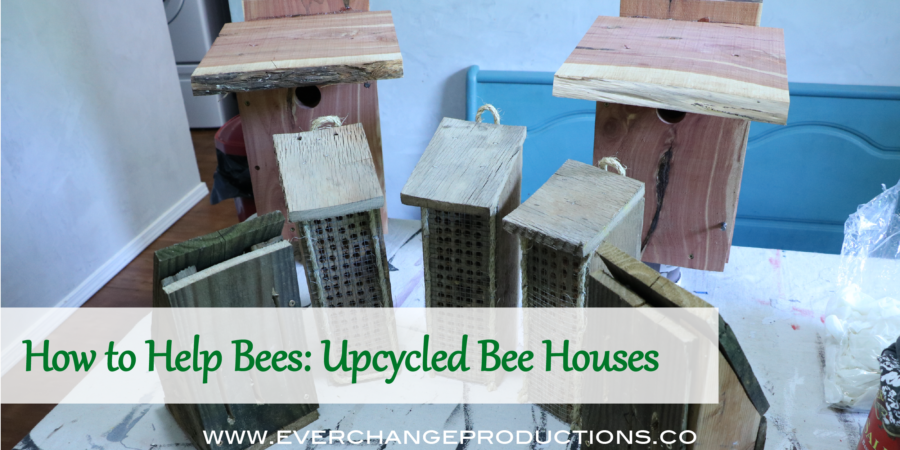
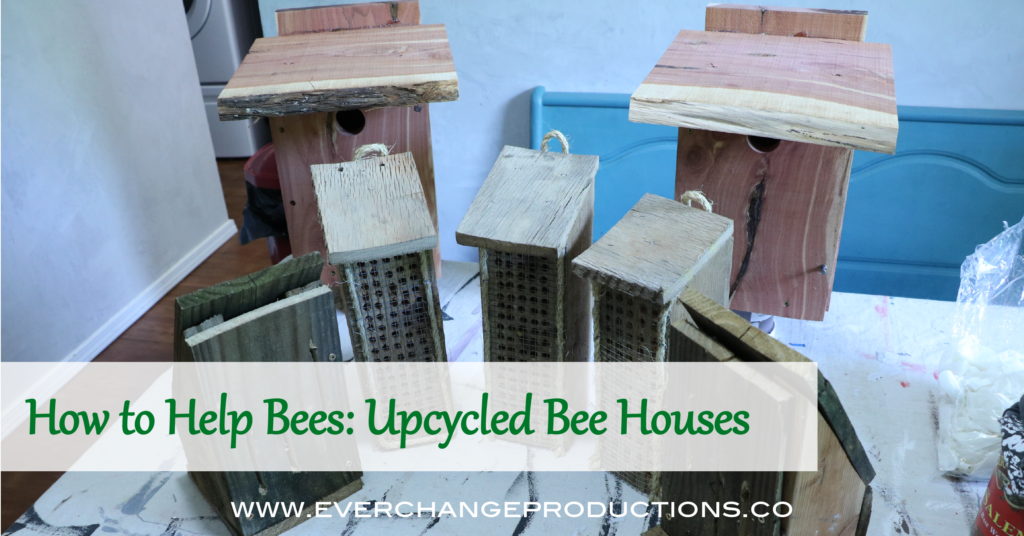
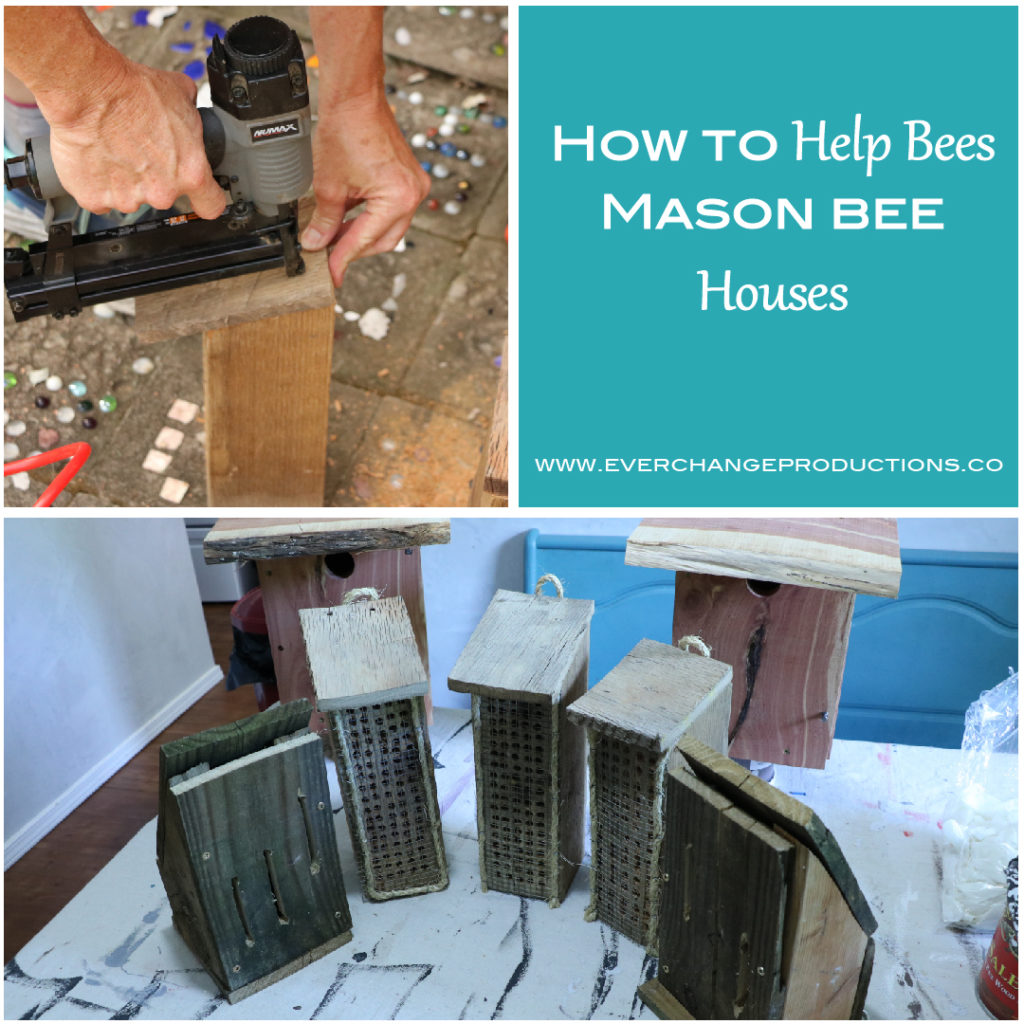
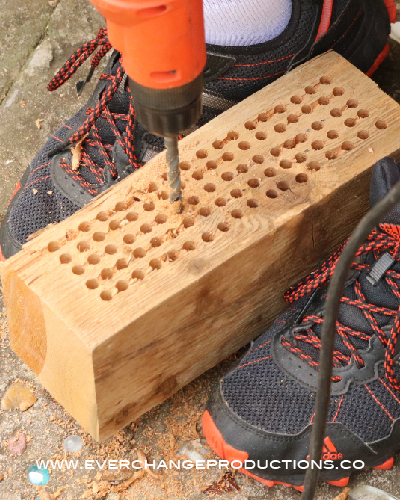
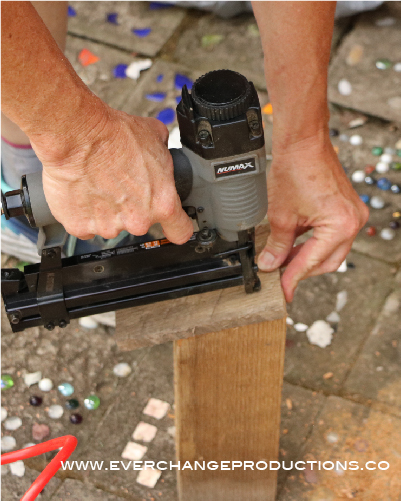
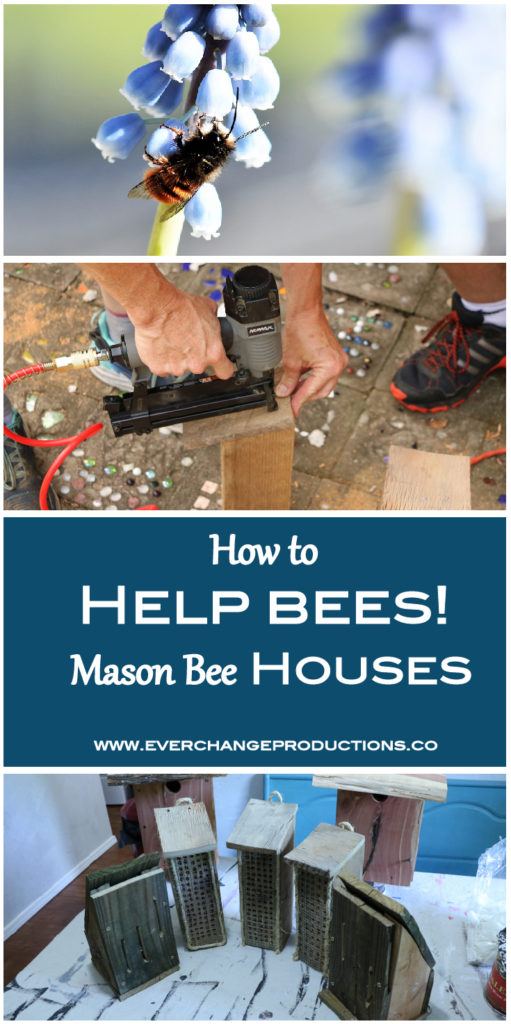
This is so cool and so simple. Even I could make these. And probably for free. Thanks for sharing this!
Thank you! I’m glad you found it helpful!
[…] include debris, sticks and hollow stems, birdhouses such as these made from reclaimed materials, mason bee houses for solitary bees, and these butterfly houses can provide shelter, particularly in winter for many species of helpful […]